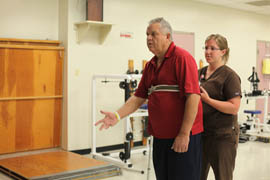Cronkite News has moved to a new home at cronkitenews.azpbs.org. Use this site to search archives from 2011 to May 2015. You can search the new site for current stories.
Medicine increasingly turning to video games to speed recovery
PHOENIX – Stephen Yates lost movement in his left side after suffering a stroke about a month ago. Now improving his strength at the Banner Good Samaritan Rehabilitation Center, he’s climbing stairs, using exercise equipment – and playing video games.
The latter may evoke images of sitting around and staring at a TV, but that’s anything but the case here. A few times a week Yates, 63, bowls through Xbox Kinect, a gaming system that doesn’t require a controller and allows him to use his whole body.
The goal is helping Yates improve manual dexterity on the left side. Although he bowls with his right arm, he said the game improves his balance.
Prior to his stroke, Yates said he only played video games occasionally with his children and grandchildren.
“Only when my kids need a good laugh, then they have me play,” he said.
Robert Djergaian, the center’s medical director for rehabilitation, said that patients typically enjoy the video games because they are a fun escape from some of the other more difficult forms of physical therapy.
“I think this gives people the opportunity to work on things that potentially are more fun and also gives people the idea that they’ll be able to return to enjoyable activities in the future and there is something for them to look forward to,” he said.
Suzanne Dilli, coordinator of the Banner Rehabilitation Innovative Technology Environment, said the program was designed in 2008 to integrate new technologies and better serve patients.
Dilli said the program uses both Xbox Kinect and the Nintendo Wii, a gaming system that requires a single hand-held controller. She said 50-75 percent of patients use video game therapy during their time at the center.
She said she sometimes organizes video game tournaments for patients to allow for socialization and add motivation. The winner gets bragging rights and a medal.
“Some patients love that medal,” Dilli said. “They’ll wear that medal every day that they’re here.”
Kathleen Ganley, physical therapy program director for Northern Arizona University at the Phoenix Biomedical Campus, said that video games have recently become a popular topic in the physical therapy world.
Ganley said that she believes video games can be very effective in physical therapy because they provide an escape from monotony and increase repetitions.
“It’s oftentimes easier for a person to understand what you want them to do if you can say, ‘Knock down the pins,’ versus ‘I want you to squat, now stand back up,’” Ganley said. “You can put it around a task and you can also communicate a little bit easier.”
Ganley said one obstacle to this form of therapy is when elderly patients aren’t familiar with video games.
“It’s foreign to them, and they’re completely uncomfortable with it and don’t want to interact with this machine at all,” Ganley said.
That being said, video games are gaining acceptance in health care.
Ashish Amresh, assistant professor at the College of Technology and Innovation at Arizona State University at the Polytechnic Campus, has been working with video games for 15 years and has studied the use of video games as an education and training mechanism.
Recently, he helped develop a game to increase physical activity in children. He is also working on a game that reintroduces cancer survivors to normal social situations after treatment.
“One of the great things that games do is the ability to virtualize the real world and be able to role-play situations that you may end up facing and be better prepared when you end up in that situation,” Amresh said.
Amresh said there is a fine line between education and fun.
“One thing I try to emphasize in every game that we make … is that you cannot lose fun because who wants to play a game that’s not fun?” Amresh said.
Although Dilli said it would be nice to have some more specialized video games for the Banner Good Samaritan Rehabilitation Center, she said that the center will stick with off-the-shelf games for now.
“One of the problems with some of those games is they become very expensive for a facility to purchase, and also then patients aren’t able to do it at home,” she said.
For now, Yates said he will continue working to increase his mobility and to improve his Kinect Bowling score of 83. He said that in his prime he used to bowl 230 in a real bowling alley.
“Eighty-three is not real good right now, but I’m going to get better,” he said.








